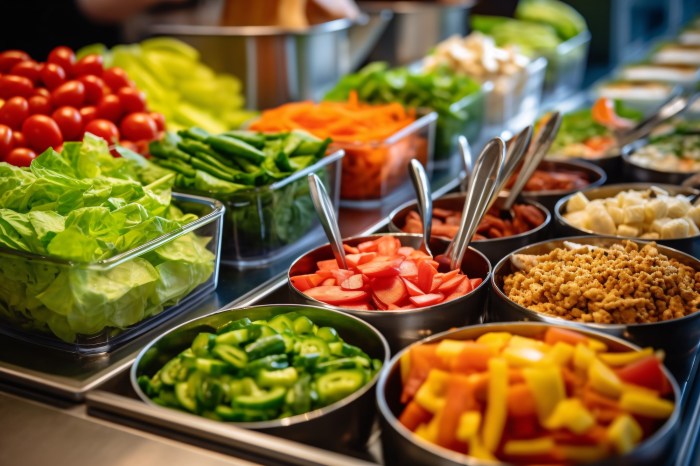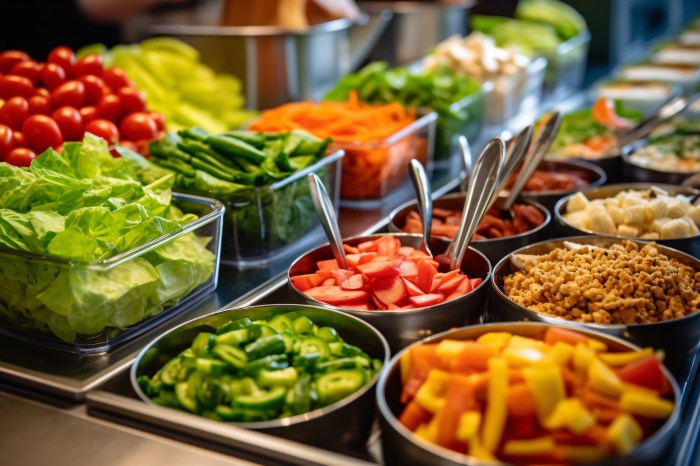What to eat and drink in Bali? This guide dives deep into the island’s incredible culinary scene, from traditional Balinese dishes to trendy modern restaurants, mouth-watering street food, and refreshing drinks. Get ready to explore the diverse flavors and experiences that await you.
This comprehensive guide covers everything from local cuisine and modern eateries to street food, drinks, and unique dining experiences. It also addresses dietary considerations, food markets, and food safety, ensuring you have all the information you need for a memorable culinary adventure in Bali.
Local Cuisine
Balinese cuisine, a vibrant tapestry woven from centuries of tradition and cultural exchange, offers a unique culinary experience. From the fragrant spices that dance on the tongue to the artful presentation of each dish, Balinese food is a reflection of the island’s rich history and spiritual beliefs. The emphasis on fresh, local ingredients and innovative preparation techniques makes Balinese cuisine a delight for both seasoned foodies and casual diners alike.The core of Balinese culinary traditions lies in the skillful blending of flavors and the use of ingredients readily available on the island.
Each dish tells a story, reflecting the island’s diverse cultural influences and its close connection to nature.
Traditional Balinese Dishes
Balinese cuisine boasts a wide array of flavorful dishes, each with its own unique characteristics. The following are five prominent examples of traditional Balinese dishes, highlighting their ingredients and preparation methods.
- Lawar: A dish of seasoned minced meat or poultry, often mixed with various vegetables and spices. Common ingredients include beef, chicken, or pork, combined with shredded coconut, shallots, ginger, turmeric, and a variety of other spices. The meat is usually cooked in a traditional way, often using a blend of spices and herbs, to give it a unique flavor.
The dish is known for its bold and savory taste. In Balinese society, Lawar is often served during ceremonies and celebrations, symbolizing prosperity and abundance.
- Gado-Gado: A refreshing salad-like dish featuring a mix of vegetables, tofu, and tempeh, tossed in a peanut sauce. The ingredients commonly include various leafy greens, bean sprouts, cucumbers, and shredded carrots. The vegetables are often blanched or stir-fried before being combined with a savory peanut sauce. Gado-Gado holds a significant place in Balinese cuisine, representing a light and nutritious meal, often enjoyed as a side dish or as a main course.
- Sate Lilit: Skewered meat or seafood marinated in a blend of spices and herbs, then grilled over charcoal. The marinade often includes turmeric, lemongrass, galangal, and other local herbs, adding a unique depth of flavor to the meat or fish. Sate Lilit is often served with a side of peanut sauce or a variety of vegetable condiments. The dish is traditionally associated with communal gatherings and celebrations, representing a shared experience and enjoyment of the flavors of the island.
- Nasi Goreng: A flavorful fried rice dish, often containing various meats and vegetables. The ingredients usually include rice, shredded chicken or beef, hard-boiled eggs, vegetables such as bean sprouts and onions, and a variety of spices, including garlic, shallots, and turmeric. The dish is typically prepared by quickly sautéing the ingredients in a wok or pan until they reach a desired level of crispiness.
Nasi Goreng is a staple dish in Balinese cuisine, often enjoyed as a main course.
- Babi Guling: A whole roasted suckling pig, marinated in a blend of spices and herbs, and then cooked over a wood fire until tender and crispy. The marinade often includes lemongrass, galangal, turmeric, and other aromatic spices. The dish is typically cooked in a traditional clay oven. Babi Guling holds significant cultural importance as it is often served during special occasions and festivals, symbolizing prosperity and abundance.
Unique Balinese Cooking Techniques
Several unique cooking techniques contribute to the distinct flavor profile of Balinese cuisine. These techniques often have historical roots in the island’s agricultural practices and resourcefulness.
- Bumbu Halus: A technique of finely grinding spices into a paste. This method is used to infuse dishes with complex flavors and aromas. This technique allows the spices to release their full flavor potential, creating a rich and nuanced taste profile. The process involves using a mortar and pestle, which is a traditional tool used in Balinese households and is essential for preparing this spice paste.
- Using Clay Pots: The use of clay pots for cooking is a time-honored tradition in Balinese cuisine. This technique allows for even heat distribution, resulting in tender and flavorful dishes. The porous nature of the clay pots allows for the slow release of moisture, creating a unique texture and flavor profile in dishes like Babi Guling. The use of clay pots is a testament to the island’s deep connection with nature and its resourceful use of local materials.
- Slow Cooking Over Wood Fire: The slow cooking process over a wood fire is a crucial part of many Balinese dishes, particularly those involving meats and vegetables. This method allows the ingredients to develop deep flavors and aromas, resulting in a tender and savory outcome. It is a technique that has been passed down through generations, emphasizing the use of natural heat sources.
Comparison of Traditional Balinese Dishes to Similar Southeast Asian Dishes
The following table highlights similarities and differences between traditional Balinese dishes and similar dishes from other Southeast Asian countries.
| Dish | Balinese Version | Similar Dishes in Other Southeast Asian Countries | Key Differences |
|---|---|---|---|
| Lawar | Minced meat or poultry with vegetables and spices | Other Southeast Asian dishes featuring minced meats and vegetables | Unique blend of Balinese spices and preparation methods |
| Gado-Gado | Vegetables, tofu, tempeh, peanut sauce | Similar salad dishes in Indonesia and other Southeast Asian countries | The specific ingredients and spice blend often varies |
| Sate Lilit | Skewered meat or seafood marinated in Balinese spices | Satay from various Southeast Asian countries | Unique marinade and cooking method |
| Nasi Goreng | Fried rice with Balinese spices and ingredients | Nasi Goreng from Indonesia and other Southeast Asian countries | Specific spices and variations in the ingredients |
| Babi Guling | Whole roasted suckling pig | Roasted pig dishes in other Southeast Asian countries | Specific Balinese marinade and cooking technique |
Modern Eateries

Bali’s culinary scene is constantly evolving, blending traditional flavors with modern techniques and international influences. Beyond the iconic Warungs and traditional restaurants, a vibrant array of modern eateries offers unique dining experiences, reflecting the island’s cosmopolitan spirit. These establishments showcase innovative dishes, stylish ambiances, and often feature a fusion of cuisines, attracting both locals and tourists.This section delves into the world of modern Balinese eateries, highlighting their unique characteristics, culinary styles, and the diverse dining options they provide.
It also explores the price spectrum across different restaurant types, providing a helpful comparison.
Popular Modern Restaurants in Bali
Bali boasts a growing number of popular modern restaurants. Here are five examples, each with a distinct culinary style:
- The Lawn: Known for its exquisite modern Indonesian cuisine, The Lawn utilizes fresh, locally sourced ingredients in innovative preparations. The restaurant’s ambiance is sophisticated and elegant, with a lush outdoor setting that seamlessly blends with the tropical environment.
- Locavore: This restaurant emphasizes sustainability and locally-sourced ingredients, crafting dishes that celebrate the bounty of Balinese produce. The atmosphere is relaxed and inviting, reflecting a commitment to environmentally conscious dining.
- Nalu: Nalu offers a sophisticated take on international cuisine, with an emphasis on fresh seafood and globally-inspired dishes. The restaurant’s sophisticated design and warm lighting create a chic ambiance that complements the culinary experience.
- Potato Head Beach Club: This popular beachfront venue is a stylish destination, serving up an array of global cuisine with a focus on high-quality ingredients. The lively atmosphere and breathtaking views make it a sought-after dining spot.
- The Samadi: This restaurant presents a refined dining experience, combining a sophisticated ambiance with modern Balinese dishes and international influences. The restaurant’s focus on presentation and flavor profiles creates a luxurious atmosphere.
Types of Cuisine in Bali
The culinary landscape of Bali is diverse, encompassing a range of international and fusion cuisines. Balinese restaurants are embracing innovative approaches, blending traditional flavors with global influences.
- Modern Indonesian Cuisine: Restaurants like The Lawn are reimagining traditional Indonesian dishes, employing modern culinary techniques to create sophisticated and flavourful experiences. Expect creative interpretations of familiar favorites.
- International Fusion: Numerous restaurants offer international cuisine, incorporating global flavors and techniques. Expect to find influences from Italian, Japanese, American, and more, often combined with Balinese ingredients.
- Seafood-focused Fusion: Many restaurants, particularly those near the coast, prioritize fresh seafood. Expect dishes combining local seafood with global culinary techniques and flavors.
Price Comparison of Meals
The price range for meals in Bali varies considerably depending on the type of restaurant. Warungs, known for their affordable and authentic cuisine, are a budget-friendly option. Mid-range restaurants offer a balance between price and quality. Luxury restaurants, on the other hand, typically command higher prices, reflecting their upscale ambiance, high-quality ingredients, and meticulous service. Consider the type of experience you seek when deciding on a restaurant and your budget.
Balinese Fusion Dishes
Balinese cuisine is increasingly incorporating elements of other cultures, leading to unique fusion dishes.
| Dish | Origin Story |
|---|---|
| Sate Lilit with Peanut Sauce | Traditional Balinese Satay (Sate) with a twist, featuring marinated skewers of meat (often chicken or pork) wrapped in banana leaves and served with a smooth peanut sauce. This dish demonstrates the integration of traditional Indonesian grilling techniques with a global touch, showcasing the adaptability of Balinese cuisine. |
| Gado-Gado with Grilled Salmon | A classic Indonesian salad (Gado-Gado) elevated with a grilled salmon topping. This dish exemplifies how Balinese cuisine is incorporating international influences, like seafood, into familiar dishes, creating a unique fusion. |
| Nasi Goreng with Shrimp Tempura | A popular Indonesian fried rice (Nasi Goreng) enhanced with crispy shrimp tempura. This dish highlights the blending of Balinese rice dishes with elements from Japanese cuisine, resulting in a fusion dish. |
Street Food and Snacks: What To Eat And Drink In Bali
Bali’s vibrant street food scene is a testament to its diverse culinary heritage. From bustling markets to quiet side streets, the aroma of sizzling spices and freshly prepared treats fills the air, beckoning visitors to sample local delicacies. This vibrant food culture is a significant part of the island’s character, offering a taste of authenticity and affordability.The street food scene in Bali is a microcosm of the island’s cultural richness, reflecting the unique blend of Indonesian and regional influences.
This culinary landscape showcases a spectrum of flavors, textures, and ingredients, offering an accessible and affordable way to experience Balinese cuisine.
Common Street Food Options
The street food scene in Bali is incredibly diverse, offering a wide array of options that cater to different tastes and preferences. Expect to encounter a range of flavors and textures, from the spicy and savory to the sweet and tangy.
Bali’s culinary scene is amazing, from vibrant warungs serving fresh seafood to upscale restaurants showcasing local ingredients. While exploring the delicious food scene in Bali, you might also want to consider the incredible experiences available in the Maldives, a truly stunning destination for adventure seekers. Check out the top things to do in maldives for some ideas on how to make the most of your trip.
From street food to fine dining, Bali has something for everyone, and the incredible variety of flavors will leave you wanting more.
- Sate: Skewered meats, often marinated in a blend of spices and herbs, are grilled to perfection. The textures range from tender and juicy to slightly charred, while the flavors are a delightful mix of sweet, savory, and spicy, depending on the marinade. Variations include chicken, beef, pork, and seafood satay.
- Lontong: This traditional Indonesian dish comprises steamed rice cakes served with a variety of side dishes like shredded chicken or beef, vegetables, and a flavorful sauce. The textures are a delightful contrast of the firm rice cake and the soft, tender meat and vegetables, while the flavors are savory and refreshing.
- Bakso: Meatballs, usually beef or chicken, simmered in a rich broth with various vegetables and noodles. The texture of the meatballs is typically soft and bouncy, and the broth is a comforting blend of savory flavors.
- Warung: A local eatery, often a small kiosk or stall, serving a wide array of simple dishes. The food is typically cooked in a rustic style, with varied textures and flavors that capture the essence of local cooking.
- Fruit juices: Freshly squeezed fruit juices are readily available and a refreshing way to cool down on a hot day. The texture varies depending on the fruit, ranging from smooth and creamy to pulpy and juicy, while the flavors are naturally sweet and refreshing.
Hygiene Practices
Hygiene practices surrounding street food in Bali are a subject of ongoing attention and improvement. While many stalls maintain a reasonable level of cleanliness, it’s essential to exercise caution and choose stalls that appear hygienic. Look for stalls with readily available handwashing facilities for vendors and customers, and be mindful of how food is handled. Observe if the food is cooked in clean and sanitary conditions.
The most important factor to consider is to choose stalls with a visible commitment to hygiene, as it directly affects the quality and safety of the food.
Unique Street Food Recipes
Balinese street food often incorporates unique flavor combinations and preparation methods. Here are three examples:
- Gado-Gado: This salad-like dish combines vegetables, tofu, and tempeh in a peanut sauce. Ingredients include shredded vegetables (cabbage, carrots, cucumber, and spinach), boiled tofu and tempeh, and peanut sauce made with peanuts, lime juice, and spices. The cooking process involves first preparing the vegetables, then cooking the tofu and tempeh. The ingredients are then combined in the peanut sauce and served chilled.
- Nasi Goreng: Fried rice, a staple in Indonesian cuisine, typically includes eggs, vegetables, and protein like chicken or shrimp. The cooking process involves stir-frying the rice, eggs, and vegetables in a pan with spices. The ingredients include cooked rice, eggs, chopped vegetables (onions, peppers, and garlic), and protein (chicken or shrimp). The dish is typically seasoned with soy sauce, fish sauce, and spices.
The cooking process is completed by stirring-frying until the rice is heated through and the ingredients are well combined.
- Sate Lilit: Skewered minced meat, typically chicken or pork, wrapped in banana leaves and grilled. The ingredients include minced meat, banana leaves, and spices. The cooking process involves wrapping the minced meat in banana leaves and grilling until cooked through. The flavors are smoky and savory.
Price Range
The cost of street food in Bali varies considerably based on location, the type of food, and the size of the portion.
| Food Item | Price Range (IDR) | Location |
|---|---|---|
| Sate | 10,000 – 20,000 | Seminyak, Kuta |
| Gado-Gado | 15,000 – 25,000 | Ubud, Denpasar |
| Nasi Goreng | 10,000 – 20,000 | Legian, Sanur |
| Fruit Juice | 5,000 – 10,000 | Everywhere |
Famous Stalls
Numerous stalls and warungs throughout Bali are known for their specialized street food offerings. Determining the most “famous” is subjective, but some consistently receive high praise for their particular dishes.
- [Stall Name]: Known for their exceptional Gado-Gado.
- [Stall Name]: Highly regarded for their savory and flavorful Sate.
- [Stall Name]: Renowned for their authentic Nasi Goreng.
Drinks
Bali’s vibrant culture extends beyond its delectable cuisine to a rich tapestry of refreshing beverages. From traditional herbal concoctions to modern fruit creations, the island offers a diverse selection to quench any thirst. The local drinks often hold deep cultural significance, reflecting the island’s connection to nature and its unique traditions.Traditional Balinese beverages often incorporate local ingredients and have symbolic meanings.
Many are believed to possess medicinal properties or are prepared with specific rituals. They provide a glimpse into the island’s rich heritage.
Traditional Balinese Beverages
Traditional Balinese beverages, often steeped in ritual and folklore, are an integral part of the island’s culture. These drinks are typically made with natural ingredients, showcasing the ingenuity and resourcefulness of the Balinese people.
- Serbat: A refreshing drink made from coconut milk, water, and various spices and herbs, often served chilled. It is frequently used in ceremonies and is believed to have cooling and medicinal properties. The spices and herbs used in the drink vary and can include ginger, turmeric, and pandan leaves.
- Wedang Jahe: A warm ginger drink, commonly enjoyed during the cooler months. It is a traditional remedy for colds and sore throats. The ginger is often combined with other spices, such as cloves or cinnamon, enhancing its flavor and purported healing properties.
- Es Campur: A blended iced dessert drink, typically a mix of shaved ice, fruit, and condensed milk. It’s a popular choice for its refreshing flavors and texture. It’s often found at local cafes and street stalls.
Fruit Juices and Smoothies
Bali’s abundance of tropical fruits translates to a wide array of fresh juices and smoothies. These vibrant drinks are a popular choice for a quick and healthy refreshment.
- Mango Juice: Freshly squeezed mango juice is a classic choice, highlighting the sweetness and richness of the tropical fruit. It’s readily available at juice bars and local markets.
- Pineapple Juice: Pineapple juice is a refreshing and tangy alternative, offering a burst of tropical flavor. Its vibrant color and slightly acidic taste make it a popular choice.
- Avocado Smoothie: Avocado smoothies are a healthy and creamy option, blending the smooth texture of avocados with other fruits or vegetables. This smoothie is a popular choice for those looking for a nutritious and filling drink.
Unique Alcoholic Beverages
Beyond the traditional beverages, Bali offers a selection of unique alcoholic drinks.
Bali’s got amazing food and drink, from fresh seafood to vibrant fruit juices. The incredible flavors are a must-try for any visitor. While the stunning architecture of the rebuilt Notre Dame Cathedral notre dame cathedral rebuilt is a testament to human ingenuity, Balinese cuisine remains a highlight of the island’s offerings. From nasi goreng to satay, there’s a feast waiting for you.
- Arak Bali: A traditional Balinese rice wine. It is a spirit made from fermented rice and has a distinct taste that is often described as slightly sweet and spicy. It is often enjoyed with local cuisine.
- Tuak: A traditional fermented palm wine, varying in sweetness depending on the palm type and fermentation process. It is often served in smaller quantities, as part of a cultural experience. The taste profile of tuak can range from slightly sweet to more acidic, depending on the fermentation process and the specific type of palm used.
- Local Beer: Bali boasts a selection of local brews, providing a taste of the island’s unique offerings. These are often lighter and more refreshing than international brands, and can be a great way to experience the local flavors.
Price Comparison
The cost of drinks in Bali varies greatly depending on whether they are traditional or imported.
| Drink Type | Approximate Price (USD) |
|---|---|
| Traditional Balinese drinks (Serbat, Wedang Jahe) | $1-3 |
| Imported soft drinks | $1.50-3 |
| Fruit juices | $2-4 |
| Imported alcoholic beverages | $4-10+ |
Healthy and Refreshing Drinks
Bali’s tropical climate makes fresh coconut water a must-have for staying hydrated.
- Fresh Coconut Water: An excellent source of electrolytes and hydration, readily available throughout the island. It’s a popular choice for a refreshing and healthy beverage.
Dining Experiences
Bali’s culinary scene extends beyond simple meals; it offers immersive experiences that connect you with the island’s culture and nature. Beyond the delicious local cuisine, modern eateries, and street food, unique dining settings await those seeking a truly memorable experience. These experiences often incorporate traditional Balinese elements, creating an atmosphere unlike any other.Beyond the familiar flavors, Bali offers opportunities to savor its rich culture through its dining experiences.
These experiences are carefully curated to provide an unforgettable and immersive encounter with Balinese traditions. They are more than just a meal; they are an exploration of the island’s heart and soul.
Unique Dining Experiences
Various dining experiences cater to different preferences. Choosing one that aligns with your interests ensures a memorable and authentic Balinese adventure. Consider factors such as the desired ambiance, cultural immersion, and budget when selecting a dining experience.
- Traditional Balinese Village Dinner: Immerse yourself in the vibrant culture of a Balinese village with a traditional dinner. These dinners often include cultural performances, such as Kecak dance or traditional music. The atmosphere is typically intimate and surrounded by the local village ambiance. The performances are an essential part of the experience, showcasing the local art and heritage. The ambiance is lively and full of energy, with a focus on community and tradition.
Expect a warm and welcoming atmosphere that enhances the immersive experience. The cost for these dinners can range from US$50 to US$100 per person, depending on the specific venue and the extent of the cultural performances. These experiences are best enjoyed during the evening to fully appreciate the cultural performances. Choosing this experience is ideal for those seeking a deeply cultural immersion and are open to the spontaneous nature of a village setting.
- Beachfront Dining with Sunset Views: Indulge in a romantic dinner overlooking the breathtaking sunset. Many restaurants along the coast offer stunning ocean views, creating a serene and romantic ambiance. The setting often features open-air seating areas or beautifully decorated terraces. The experience is ideal for couples seeking a relaxed and romantic atmosphere. Prices for these dinners typically range from US$75 to US$150 per person, depending on the location, the restaurant’s reputation, and the quality of the food and service.
The best time to experience this is during the golden hour of sunset for the most visually captivating experience.
- Cooking Class with a Local Chef: Learn the secrets of Balinese cuisine by participating in a hands-on cooking class with a local chef. These classes often involve a guided tour of local markets, introducing you to the fresh ingredients used in traditional Balinese dishes. The atmosphere is interactive and educational, making it ideal for those interested in learning about the culinary heritage of the region.
Bali’s got incredible street food, from satays to fresh juices. Thinking about a tropical getaway? The British Virgin Islands are reopening soon, offering stunning beaches and a different kind of culinary experience. But if you’re looking for vibrant local flavours and delicious rice dishes, Bali is still the place to be! It’s a feast for the senses, from spicy rendang to sweet sticky rice, and there’s something for every taste bud.
british virgin islands reopening promises a refreshing change, but for the ultimate Balinese experience, you can’t beat it.
The ambiance is lively and energetic, filled with the sounds of chopping and cooking. The cost typically ranges from US$50 to US$120 per person, depending on the length of the class and the complexity of the dishes prepared. The ideal time to take a cooking class is during the day to fully participate in the hands-on experience and to appreciate the local market’s vibrancy.
Choosing the Right Experience
Consider your preferences when selecting a dining experience. If you prioritize cultural immersion, a traditional village dinner might be perfect. For a romantic setting, beachfront dining is an excellent choice. Those interested in learning culinary skills may prefer a cooking class. The price range varies greatly, and it is important to plan your budget accordingly.
Best Time to Enjoy Different Experiences
The best time to experience each dining option depends on the desired atmosphere. Traditional village dinners are best enjoyed in the evening to fully appreciate the cultural performances. Beachfront dinners are ideal during the golden hour for breathtaking sunset views. Cooking classes are best during the day to fully participate in the hands-on experience.
Dietary Considerations
Bali’s vibrant culinary scene offers something for everyone, but understanding dietary restrictions is key to a truly enjoyable dining experience. From vegetarian and vegan options to gluten-free choices and halal alternatives, this section will guide you through navigating Bali’s diverse food landscape with ease. Knowing what’s available allows you to personalize your meals and savor the local flavors while staying true to your dietary needs.
Vegetarian and Vegan Options
Bali, with its strong emphasis on fresh produce and vegetarian traditions, boasts a wealth of vegetarian and vegan-friendly restaurants and food stalls. Many Warungs (small family-run restaurants) and cafes offer delicious vegetarian curries, vegetable stir-fries, and fresh fruit salads. Beyond the common options, you’ll find creative dishes incorporating tofu, tempeh, and other plant-based proteins. Restaurants specializing in vegetarian and vegan cuisine are also popping up, providing more diverse options for those seeking a plant-based experience.
Gluten-Free Dishes, What to eat and drink in bali
Many restaurants and food stalls in Bali can accommodate gluten-free needs, but it’s crucial to communicate your dietary requirements clearly. Be upfront with the staff about your gluten-free needs. Checking the ingredients and ensuring the dishes are prepared separately from those containing gluten is important. Here are some dishes commonly suitable for gluten-free diets:
- Nasi Campur: This mixed rice dish is usually made with steamed rice, vegetables, and meat (or tofu/tempeh). The rice itself is gluten-free, and with careful selection, most of the side dishes can be easily adapted for a gluten-free meal. Be sure to specify any ingredients that might contain gluten.
- Gado-Gado: This vibrant salad features a mix of vegetables, tofu or tempeh, and peanut sauce. It’s generally gluten-free, but inquire about the peanut sauce preparation if you have specific concerns. Some versions might include a gluten-containing ingredient in the peanut sauce.
- Fresh Fruit Salad: A refreshing and gluten-free option, consisting of a variety of tropical fruits. This is a naturally gluten-free choice and an excellent way to enjoy Bali’s fresh produce.
Halal Food Options
Bali has a significant Muslim population, and halal food options are readily available in many areas. Look for restaurants with the halal certification or clearly indicate your needs to the staff. Many Warungs offer halal variations of traditional dishes, such as rendang (a spiced beef dish), or you can find dedicated halal restaurants in tourist areas. These restaurants will cater to specific halal needs.
Importance of Dietary Restrictions
Planning your meals in advance with awareness of your dietary restrictions is essential for a smooth and satisfying culinary journey in Bali. This allows you to fully enjoy the local flavors and experience without compromising your health or dietary choices. Proper communication with restaurant staff about your needs ensures you receive food that aligns with your dietary requirements, allowing you to fully enjoy the local cuisine.
Ordering Food with Dietary Requirements
Communicating your dietary restrictions effectively is crucial. When ordering, explicitly state your needs. For example, you could say, “I need a gluten-free meal, please” or “Could you please ensure this dish is prepared without any gluten-containing ingredients?”. If you’re unsure about an ingredient, ask for clarification. Be prepared to describe your specific needs.
Being upfront and clear will greatly increase the chances of getting a meal that fits your dietary needs.
Food Markets and Local Shops
Bali’s vibrant food markets offer a unique glimpse into the island’s culinary heart. Beyond the tourist-oriented restaurants, these bustling marketplaces provide authentic experiences, connecting you with local vendors and fresh, affordable ingredients. These markets are more than just places to buy food; they are lively hubs of community activity, where the aroma of spices and the sounds of bartering create an unforgettable atmosphere.
Popular Food Markets in Bali
These markets are popular destinations for locals and tourists alike, offering a diverse range of fresh produce, seafood, meats, and local delicacies. They’re not just about grabbing a quick bite; they’re about immersing yourself in the culture and experiencing a genuine Balinese food scene.
- Pasar Seni (Ubud): Located in Ubud, this market is renowned for its abundance of fresh produce, including tropical fruits, vegetables, and herbs. The market also features a wide selection of local crafts, offering a complete cultural experience beyond just the food. The atmosphere is lively and bustling, with a strong sense of community. The process of buying food here involves haggling, a common practice in many Balinese markets.
The quality is generally excellent, reflecting the freshness of the produce. Prices are competitive and generally affordable, particularly for fresh produce.
- Pasar Badung (Denpasar): This large market in Denpasar boasts an impressive variety of seafood, meats, and traditional Balinese dishes. The atmosphere is energetic and vibrant, with a strong focus on the local food scene. The process of buying food is similar to other markets, often involving bargaining. Quality is generally good, but the freshness of the food can vary depending on the vendor.
Prices are competitive and are usually cheaper than many tourist-oriented restaurants.
- Pasar Kaja (Seminyak): Located in Seminyak, this market is more focused on fresh produce and local ingredients, with a strong emphasis on quality and sustainability. The ambiance is more relaxed and less overwhelming than other markets. The process of buying food is straightforward and generally efficient. The quality is high, reflecting the emphasis on freshness and local sourcing. Prices are slightly higher than in some other markets, but still generally affordable, especially for fresh produce.
Buying Food at the Markets
The process of buying food at these markets is a unique and often engaging experience. It typically involves approaching vendors, inspecting the goods, and haggling over prices. Bargaining is a common practice, and while not always necessary, it can result in a better price. Learning a few basic Indonesian phrases can also enhance your interactions with the vendors.
Cost and Quality of Food
The cost of food in these markets varies greatly depending on the specific item and the market. Generally, prices are significantly lower than in tourist restaurants. The quality of food, especially fresh produce, is often excellent due to the proximity to the source.
Price Comparison Table
| Food Item | Pasar Seni (Ubud) | Pasar Badung (Denpasar) | Pasar Kaja (Seminyak) |
|---|---|---|---|
| Mangoes (kg) | Rp 15,000 – 20,000 | Rp 10,000 – 15,000 | Rp 20,000 – 25,000 |
| Fresh Fish (per kg) | Rp 30,000 – 50,000 | Rp 25,000 – 40,000 | Rp 40,000 – 60,000 |
| Chicken (per kg) | Rp 25,000 – 35,000 | Rp 20,000 – 30,000 | Rp 30,000 – 40,000 |
Note: Prices are approximate and can vary depending on seasonality and supply. Rp stands for Rupiah, the Indonesian currency.
Food Safety and Hygiene
Bali’s vibrant culinary scene offers a delicious array of flavors, but understanding food safety is crucial for a worry-free and enjoyable experience. This section delves into the regulations, hygiene practices, potential risks, and steps to ensure safe food consumption in this beautiful island nation.Food safety in Bali, while generally good, requires awareness. Many restaurants and street food vendors adhere to standards, but individual vigilance plays a vital role in protecting your health.
This includes recognizing potential hazards and taking proactive measures.
Food Safety Regulations in Bali
Bali’s food safety regulations aim to protect public health. These regulations are overseen by local authorities and focus on maintaining hygiene standards in food preparation and handling. Compliance with these regulations varies among establishments, so understanding the basics is essential.
Importance of Hygiene Practices
Maintaining hygiene is critical when eating at restaurants or street food stalls. Proper handwashing before handling food, using clean utensils, and ensuring food is stored at safe temperatures are fundamental practices. Food handlers should be trained and committed to these practices to prevent contamination. A lack of hygiene can lead to the presence of harmful bacteria and viruses in food.
Potential Health Risks Associated with Unsafe Food Handling
Unsafe food handling practices can lead to various health risks. Contaminated food can cause food poisoning, characterized by symptoms like nausea, vomiting, diarrhea, and abdominal cramps. Severe cases may require hospitalization. Cross-contamination, where bacteria transfer from one food item to another, is a significant concern. Improper storage temperatures allow harmful bacteria to multiply rapidly.
This is especially important in tropical climates like Bali.
Signs of Food Poisoning
Recognizing the signs of food poisoning is crucial for prompt action. Common symptoms include nausea, vomiting, diarrhea, stomach cramps, fever, and headache. The severity and duration of these symptoms can vary depending on the cause and the amount of contaminated food consumed. If symptoms are severe or persist, seeking medical attention is essential.
Methods for Ensuring Safe Food Consumption in Bali
Several measures can ensure safe food consumption in Bali:
- Choose reputable establishments: Opt for restaurants and street food stalls that appear clean and well-maintained. Observe how food is handled and stored. Check for certifications or licenses if available. Review online reviews for hygiene practices.
- Practice proper hand hygiene: Wash your hands thoroughly with soap and water before eating and after touching potentially contaminated surfaces. This is especially important before eating at street food stalls.
- Select food carefully: Avoid eating food that appears to be spoiled, or has been sitting out for a prolonged period. If unsure, don’t consume it. Avoid food from vendors who don’t appear to follow proper hygiene practices.
- Cooked food should be thoroughly heated: Ensure cooked dishes are steaming hot throughout. Avoid eating undercooked or lukewarm foods, especially meat and seafood.
- Store food properly: If you’re purchasing food for later, store it in a cooler with ice packs to maintain a safe temperature.
- Drink bottled water or filtered water: Drinking tap water in Bali can be risky. Stick to bottled water or water that has been purified.
By understanding the importance of food safety and adopting these practices, you can minimize risks and enjoy a safe and delicious culinary experience in Bali.
Concluding Remarks

From the rich flavors of traditional Balinese dishes to the exciting options at trendy restaurants and the vibrant street food scene, Bali offers a feast for every palate. This guide has provided a comprehensive overview of the culinary delights, ensuring your trip is filled with unforgettable food experiences. Whether you’re a seasoned foodie or a curious explorer, this guide will help you navigate Bali’s culinary landscape with confidence and delight.
















